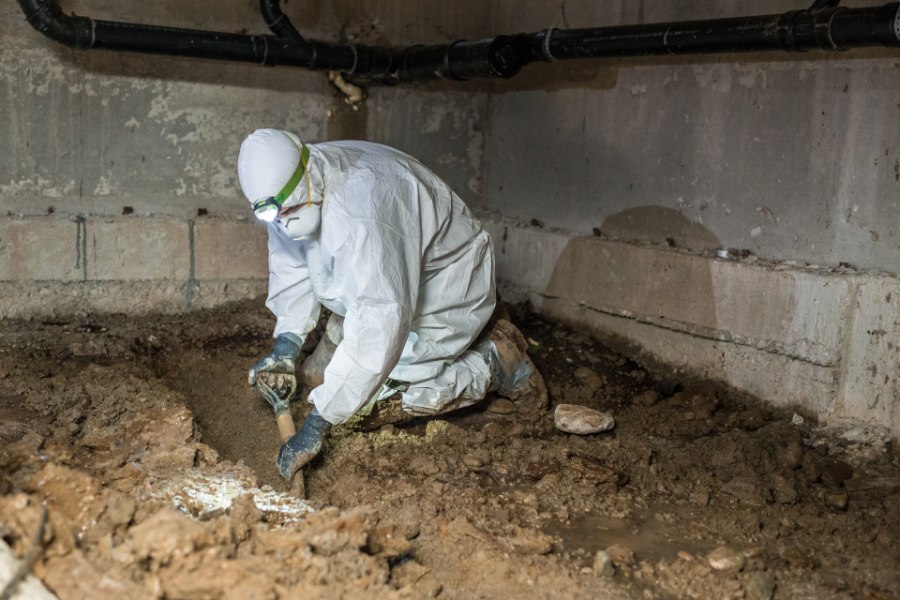
In the Pacific Northwest, water seems to be a part of our culture. This is, after all, one of the wettest climates in the U.S. by annual rainfall, and much of the region lies on the oceanic coast. As such, it seems natural for there to be water in and around your home; but is it bad if there’s water in your crawl space?
There’s a difference between a little water and a flooding problem, both of which are situations that experts at Crawl Pros can help you navigate and remediate. Read further to discover the reasons for water in the crawl space, the dangers of too much water, how to remove water from the crawl space, and when it’s time to call a crawl space company like Crawl Pros for water remediation services.
Reasons For Water In The Crawl Space
Regardless of geographic location, there are a few common reasons for excess water buildup in crawl spaces. The most common include:
- Surface Water: Surface water includes leakage from roof draining and rain gutters that aren’t properly flowing away from the house. Rain gutters will cause water to accumulate on the ground, and saturate that spot until the water makes its way into your home. This water can enter the house by following the point of least resistance — poured footing around the house and a stim wall where water can slip between the two to flood the crawl space. Additionally, surface water can enter the crawl space if the house is built on a hill, where rainwater will travel down the hill and enter the property.
- Ground Water: Groundwater comes from outside where the soil around the foundation becomes saturated by heavy rain or snow. This puts pressure on the foundation, where it can seep into the crawl space. Additionally, if you dig below the water table, water is always going to try to work its way up.
- Leaky Plumbing: Leaky plumbing may include a leaky pipe, drainage from a sink (greywater), and drainage from a toilet (brown water). Pipe bursts and frozen pipes may also lead to leakage. Even with a vapor barrier, the water will remain in the space on top of the liner until it evaporates.
Dangers of Water In The Crawl Space
The dangers of water in crawl spaces varies from annoying to extremely uncomfortable. Water in the crawl space can:
- Ruin your insulation, causing higher energy bills
- Rot wood and rust metal components like pipes and nails, damaging the structural integrity of your home
- Introduce dust mites and pests (like ants or rats), risking both the health/comfortability of the home’s residents as well as the home’s structural integrity
- Create a mold problem
More on Dust Mites in Your Crawl Space
Dust mites and pests are also the result of water in the crawl space. Dust mites live in your bedding, carpet, and furniture and release droppings that trigger allergies and asthma. Other pests include bugs, termites, spiders, mice, rats, and even snakes which are unpleasant and unwelcome visitors for most homeowners.
More on Mold in Your Crawl Space
Perhaps most concerning of all of the issues listed above, however, is mold. Mold needs organic material, moisture, and temperature — all factors that exist when there is water in a crawl space. The dead organic material that mold feasts on includes wood, paper, and cardboard, materials that are commonly found in crawl spaces. Mold also eats dead insects, which are usually present, regardless of water.
When there is mold in your crawl space, mold spores are pushed into your home, causing potential health issues. Additionally, when buying or selling, most people will walk away from a home that has mold because you don’t know how far the mold spreads.
How To Remove Water From The Crawl Space
Below we’ve listed several steps to take if you suspect excess water in your crawl space.
1. Determine If You Have Too Much Water in Your Crawl Space
The first step in removing water from your crawl space is determining if you need to. Especially in the PNW, due to excess rain and wet soil, there is a normal amount of water in your crawl space; when there is water in a corner around the footing, for example, that’s normal. In contrast, however, you should seek help if there’s a large amount of water that’s pushing humidity into the home, rotting wood, or on top of the vapor barrier.
2. Call a Professional Crawl Space Company
If you’ve determined you have excess water in your crawl space (or need help identifying whether the amount you have is normal), it’s best to call a professional to help and remove it. Crawl Pros offer personable, local service and a lifetime guarantee. For crawl space services in Washington and Oregon, call Crawl Pros!
3. Remove Excess Water
There are a few techniques employed to clean up excess water before installing prevention systems. If there are only a few puddles, you can use a wet-vac to suck up the water and empty it outdoors. However, a pump is the most useful removal tool for crawl spaces with excess water. To remove water from your crawl space with a pump, we’ll place the suction end of the hose into the floodwater, and ensure the hose empties out far away from the house. It’s important to keep distance between the dumpsite and the house so that the water can’t flow back into the crawl space.
4. Install a French Drain System & Sump Pump
Though the exact solution for your unique home may vary, our typical professional remedy for excess water in crawl spaces is to install a combination French drain and sump pump system.
A French drain is a trench with a perforated pipe and gravel that allows water to drain from your yard. It can be installed outside or inside the home. Trenching is done around the perimeter of the crawl space and throughout it. The corrugated drain pipe is placed into the trenched areas. Professional installers will then fill the trench with lava rock so dirt will not clog the sump pump. These drains are placed to direct excess water into the 15-gallon basin. This basin is strategically placed at the lowest point in the crawl space. Once the drain and pit have been constructed, the pump will be put in place and routed to the exterior gutter system for effective water removal. A purge valve is also installed to keep the water from flowing back into the crawl space. A secondary 12-Volt pump is installed and connected to a battery as a backup in case of a power outage.
A sump pump is a basin dug below the main surface of the crawl space floor that helps move water from the crawl space and out of the home. Installing a sump pump could save you from extensive repairs down the road. Even just a few inches of water can cause thousands of dollars in damage. A sump pump will reduce or eliminate this damage by diverting water away from your house when water levels rise during a storm, or if your house is susceptible to groundwater seepage. Sump pumps do not solve water problems, they merely remove the water from the basement. That’s why proper sealage and discovering the root cause of the problem are so important.
5. Replace Insulation
If necessary, we will also reinstall new insulation to ensure your home will be as energy-efficient as possible, as water-damaged insulation becomes useless. Replacing the insulation is especially important to avoid a mold problem, where moisture can collect and cause damage. So not only will we clean up the water and provide prevention systems, but we’ll also take care of damaged insulation! At Crawl Pros, we look at the complete system, from energy efficiency to pest entry points to your comfort in your home. We’ve seen it all, so we know how to deal with it all — the right way.
Looking for more information on water in crawl spaces? Read The Ultimate Guide to Crawl Space Water Removal.
Call Crawl Pros for Crawl Space Inspections
With locations in Washington and Oregon, Crawl Pros is the regional expert in crawl space and attic services. We understand common issues with houses in the region, know what to look for, and can offer thorough, accurate explanations and recommendations as a result. We’re so confident in our ability, in fact, that we offer a “Perfect Lifetime Guarantee” with all of our services, including water remediation services.
If you’re interested in scheduling Crawl Pros or Pest Pros services, please contact us by calling us or submitting the form below. We look forward to working with you!


